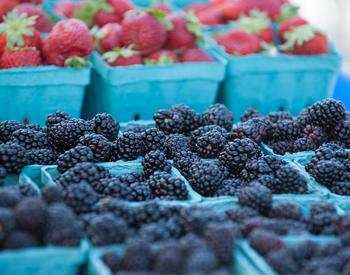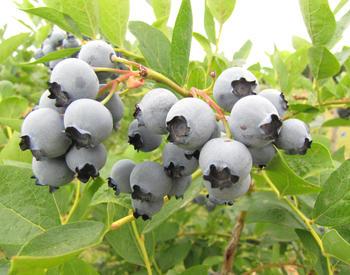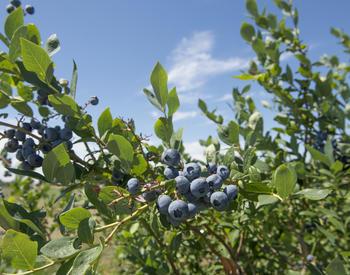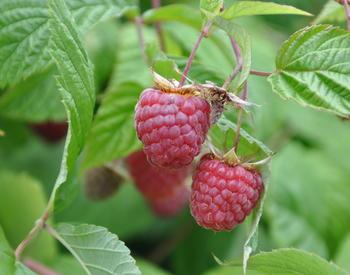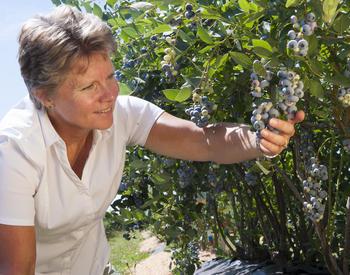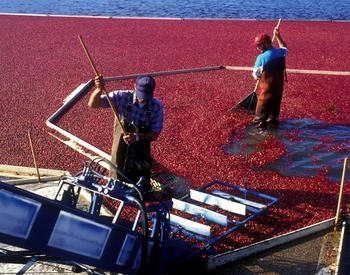Transcript
Speaker 1: From the Oregon State University Extension Service, this is Pollination, a podcast that tells the stories of researchers, land managers, and concerned citizens making bold strides to improve the health of pollinators.
I'm your host, Dr. Adoni Melopoulos, assistant professor in pollinator health in the department of horticulture. It is blueberry season in Oregon. In fact, it's blueberry season right across the Pacific Northwest on both the West, but also East sides of the Cascade Mountain Range.
But also, there's an enormous blueberry-producing area in British Columbia on the lower mainland. And I thought this would be an opportunity to highlight a project that I just love. It's a new guide produced by Pollinator Partnership, and we've had Pollinator Partnership staff on past episodes. This week, we have Kathleen Law, who's the integrated conservation manager for Pollinator Partnership Canada. And they have just come out with a new guide for protecting pollinators from pesticides in high-bush blueberries. I really love this guide.
It's so clear. It's been put together very thoughtfully. And so I'm going to have Kathleen talk about the process behind this guide, but also some of the key recommendations that can be transferred right across a lot of different crops here in the Pacific Northwest, how to grow a crop effectively and minimizing impacts on pollinators. So this week on Pollination, Kathleen Law from Pollinator Partnership talked about blueberries and how to protect bees in them. Thirst rolling. Welcome to Pollination, Kathleen.
Speaker 2: Thank you so much, Adonis. It's a pleasure to be here.
Speaker 1: Blueberry is a huge crop in the Pacific Northwest here in Oregon, but also extends up into British Columbia. Can you tell us a little bit about some of the pollination and bee health concerns around blueberries in the Pacific Northwest?
Speaker 2: Yeah, absolutely. Well, high-bush blueberry is one of the most, I think it is the most valuable crop, fruit crop in Canada and British Columbia. British Columbia alone accounts for 96% of Canadian high-bush blueberry production. Really?
Speaker 1: Wow. It's funny because you think about British Columbia and where it's grown. It's like this little, you know, this little part of the Fraser Valley and there's all that, the huge amount of production packed into one small little area. It's pretty remarkable.
Speaker 2: It is. It is quite remarkable. And of course, unsurprisingly, a lot of pollination services are involved in that amount of production. So every year, 40,000 hives are brought into the Fraser Valley to pollinate high-bush blueberry.
And in the last few years, there's been an increase in the incidence of European foul boot. And at least anecdotally, we started hearing through our networks that many beekeepers were starting to become reticent to rent out their hives for high-bush blueberry. And so this was part, not the only, but part of the impetus to work on the guide on the high-bush blueberry guide. As part of this sort of concern around the health of managed honeybees, there's been quite a bit of research coming out of agriculture and AgriFood Canada, as well as the University of British Columbia through, the National Bee Diagnostic Centre. And they're just investigating what's the possible causes and the research is ongoing. So we still don't quite know what's going on. But we're hoping, at least that with this guide, we can speak to broader pollinator health, both managed bees and wild bees. Okay.
Speaker 1: So that's great. That sets us up really well, bringing up the guide, which we really want to talk about today. So the guide is in some ways a response to some of these growing concerns around blueberry.
And the issue of European foulbrood, which we covered in an episode with Megan Milbrath, I think last year, but this time, is an issue that we have throughout the Pacific Northwest. So beekeepers are coming into pollination, and they're having these problems. But I also, I guess there's the additional issue that, you know, when you do go into a blueberry field, there are a number of native bees that actually, you know, like to go to blueberries. And so there's this issue of bee health, kind of with honeybees, but expanding out to a broader suite of bees.
Speaker 2: Yes. So you just cut it. Yeah, absolutely. Of course, you know, from an agricultural point of view, the concern is with the capacity of honeybees to pollinate these crops. But, you know, from a conservation level, we're also interested in seeing how these blueberry fields impact pollinator health and the benefits that wild pollinators can have on the Highbush blueberry production.
Speaker 1: Now, I imagine there are all sorts of best management practices that have been developed. And a lot of them are generic, you know, that we know, you know, generally what they are. Why was there, you know, for protecting bees? So there's, you know, reducing pesticide use, planting habitat. We have these generic recommendations. Why was it important to come up with a crop-specific guide? And what are some of the challenges with a crop-specific guide?
Speaker 2: Yeah, absolutely. Well, definitely, I think growers like to see their specific needs and concerns reflected and taken into account when generally we ask them to consider something new or something sort of outside of the bounds of their usual production or business concerns. So being able to speak directly to their production system is really important. Of course, the challenge with that is that though there is an increasing amount of research on, you know, pollination ecology or agroecology of Highbush blueberry, it can also look really different from one geography to another and from one type of production to another. So whether we're talking about small integrated farms, too much larger, monocultures, like larger production, and larger fields, the concerns and the management practices will look different. So it's on the one hand, we want to have some specificity, but also we can't go into too much detail because it just there's so much variation to deal with from one system to another.
Speaker 1: Well, and I imagine that there's a kind of like that is the challenge in the guide is that you do have, you know, a lot of variation in production systems. If you were to go to a province like Ontario, we're currently involved with a project in Michigan, it's very different from the Pacific Northwest where the scale is quite large. And I suppose, you know, the one thing I was really interested in this project is what the start of the project you went out and you asked growers, what do they want to see in a guide? I'm interested in what kind of what came to the top of the list of what they were looking for.
Speaker 2: Oh, yes, this was really interesting. So at the very beginning of the project, when we started putting together an outline and doing some preliminary research, we put out a survey for stakeholders, which included pesticide applicators, IPM consultants, beekeepers, and high-bush blueberry growers. And one of the questions we had was a list of possible topics to cover. The two that came out at the top with 93% of respondents saying, yes, we want this in the guide was a table of registered pesticide active ingredients for high bush blueberry with precaution levels for bees. The second one, which is the one that pleasantly surprised us was that people were interested in habitat considerations for supporting wild and managed bee health.
Speaker 1: Wow, that's what's really interesting. Because I imagine with a lot of these best management practices, the focus is on pest management. And you think that in a grower's mind, pest management is important. And it is obviously reflected in the fact that they really want a practical guide where they can go through and they've got three alternative pesticides, and they can select one over the other. But surprising that that growers themselves would identify the need for more specific resources on pollinator habitat.
Speaker 2: Absolutely. And I think I mean, I'm guessing that this is indicative of a growing appreciation for the importance of wild pollinators in agricultural production, and also how managing habitat can very much be integrated into pest management, whether it's through promoting beneficial insects, or reducing the impacts of some of the more intensive management on bee health.
Speaker 1: You know, it reminds me there is a number one thing I really love about the guide or the case studies. And here's an example of one grower who is concerned with spotted winged risophila, a major pest of blueberries, and has used habitat incorporation as a way to take out host species for blueberries and replace them with pollinator plants. Can you tell us a little bit about some of the case studies or that case study specifically about how habitat and pest management actually go together?
Speaker 2: Yeah, this was this was a really, really interesting grower to speak with. And they they grow quite a few crops, so like a diverse farm scenario. And they're not a big production, but they like to experiment and they like to try out new things. One of the things they did just recently, so in 2019, they started introducing pollinator plants along the forest edge near their blueberry fields to encourage pollinators. And they're trying to do this because or they're doing this to compensate for removing alternate hosts for spotted wing drosophila. And so they're recognizing that they have to manage for this pest, but that this action, removing the alternate hosts can also have a negative impact on the wild pollinators that they also depend on for a productive harvest. And so they're compensating for that by introducing some pollinator-supporting plants and hedges along their fields. So I thought that was a really great example of a grower who's really keeping, who has a really big picture appreciation of how all of these management practices interact.
Speaker 1: You know, I love that example. And here, when I, my mind went straight to the Pacific Northwest thinking about blackberry, wild blackberry, and the ditches as being a spotted wing drosophila host plant. Also a tremendous, you know, I was just out netting bumblebees off the last bit of blackberry bloom. And there's just, you know, a lot of diversity of long-tongued bees or a host of bees are going into blackberries. And then, you know, the removal of the first spotted wing drosophila control, you know, comes at the expense of, you know, that late season beforage. And I love the idea of thinking about that as a system, you're going to replace it. Anyway, you're going to go in and do the kind of weed control already. So you've created a nice basis. And if I suppose you don't put something in there, the blackberries will just come back.
Speaker 2: Well, yeah, absolutely, absolutely. And, and I think that's, and I think hopefully that's something that we can really promote is this, is this concept that, you know, you can get more than, you know, you can have multiple benefits from one action if you put all the pieces together. And so exactly that, if you're, if you're needing to remove a host plant for one of your pests, it's a great time to introduce, some plant species that will support production and minimize the presence of the pests. And then you, it also limits the amount of future host plant removal you'll need to do. Well, I think one thing that I really love about the guide is there's this big landscape. It's like you're in the Fraser Valley, there's your blueberry farm in the context of the environment.
And it brings all those elements together. Can you tell us a little bit about this landscape map and how the activities of the grower for pollinator health, you know, extend beyond just the, you know, the edge of where the blueberry shrubs are?
Speaker 2: Oh, yes, this is the enhancing agricultural habitat for pollinators infographic, but the map is a much better way to refer to it. So, yeah, it's basically a graphic representation of an agricultural landscape, you know, and you see different kinds of elements. So you have a crop field that, you know, could be wheat or canola or corn. You have an orchard or in this case, it would be your blueberry field. You have your roadside, you have a bit of a forest edge with a wetland. You have a farmhouse, you have pasture. Beside each of these features, you have a little description of a practice that can be integrated into this specific landscape feature that is beneficial for pollinators. And so the idea here was really to show visually that there are so many opportunities within an agricultural landscape to manage in a way that is beneficial or at least minimizes some of the impacts of agriculture.
And so it can be things like maintaining buffers around wetlands, retaining dead branches or logs for nesting sites, integrating buffers between crops and crops that will be treated with pesticides and pollinator patches, things like that are also minimizing mowing along roads, sorry, mowing along road sites.
Speaker 1: Those are all great. There was one on there I really loved because I was thinking of one of the managers of the largest cherry growers in Oregon, Mike Omeg, who I think has been a North American pollinator advocate for NAPSI in a previous year, but his home site. So he does all sorts of things all around the orchards to protect pollinators.
But if you look at his home site, he has a fairly sized home site. He's got a pollinator hedge. He has all sorts of things there right out of the spray zone. And it's kind of on the map there is like the grower, maybe you wanna like, have this really great pollinator planting right at the home site where you are. It's just a real safe place to put it.
Speaker 2: Yeah, absolutely. And that is one of the considerations we wanted to address in the guide. And again, finding that balance between specificity and broad applicability is that we do wanna create habitat in agricultural settings, but at the same time, these landscapes are subject to pesticide applications. And so where and how do we put those in a way that is beneficial for crops, but is also not creating an ecological sink or exposing pollinators to pesticides in an undue way? So that is one of the things we wanted to show with this, with this infographic and that we also address in the practices.
Speaker 1: I wanna just bring us all back to that second part that was really important to the growers, the pest management. So there's supplementary material in the action guide. Can you describe how that's laid out? I know there's a lot of difference, the growers ask for it and our growers ask for it too. There's a kind of listing of products. Tell us how it's organized.
Speaker 2: Yeah, so this is also a ridiculously long title, but it's the supplement to protecting pollinators from pesticides in high bush blueberry. And it's basically all the technical information that we couldn't fit in the guide that covers the practices. And so in this document, we wanted to start actually by giving people a sense of how pesticides are regulated, on what basis. And so we described the differences between toxicity, exposure, and risk. Then because of course, in Canada, we have the Pest Management Regulatory Agency, which is in charge of pesticide registrations and regulation, we explain their risk characterization framework. And then, so after that introduction, here are the concepts that are at play, that are used to register pesticide products.
Speaker 1: I have to say just quickly to cut in, the infographic, it's not dense text. There are some wonderful infographics in there, just describing these concepts. So I imagine a grower flipping through, they'll see it, it's like, oh, that's what's going on. So it's nicely put together that way. Anyway, sorry, I had to interrupt.
Speaker 2: Oh, thank you. Well, I'm really glad that you feel that way because it was really important for us. Like this can be very dense, it can also be very dry. And people growers, beekeepers, pesticide applicators, they're busy people, they've got work to do. And so we wanted this guide to cover a lot of ground, but also make it accessible. So you could read it cover to cover, or if you have a specific interest or question, you could flip to that section. And with the infographics, we just wanted to make it easier for people to really get a good sense of what is being described and help that information be absorbed.
Speaker 1: Okay, great. And just describe how the table's laid out, the supplementary material just quickly.
Speaker 2: Yeah, so table one, it's pretty simple. It's on the left column you have the product name. So the brand name essentially. And then on the right, you have the active ingredients. So if you're going to be working with a particular product, you can use that to look up which active ingredient is part of that product.
Speaker 1: Right, because most people see the product name, and so the table's organized by active ingredients. So it allows you to find the synonym. Okay, excellent, keep going.
Speaker 2: Yeah, so then table two, that's really the meat of it, the core of it. This one is based on PMRA classifications of precaution levels. And so basically what that means is for each active ingredient, the PMRA determines whether, for pollinators, it requires the most restrictive, moderately restrictive, or least restrictive precautions. And so with this table, you can look up whichever insecticide or pesticide product you're using and determine which of these categories it fits in, and then that can help guide you, to determine how and when you use the product.
Speaker 1: Fantastic, so you just go through, it's like red, yellow, green, and it allows you if you've got three different, I've got two fungicides, you gotta apply, hey, this one looks a little bit better. It's got a green rather than a yellow, then that helps you, and it's equally effective, and equally, prices are the same, then it helps to make better decisions.
Speaker 2: Yeah, and that really is the hope, just to sort of show that there are differences between these different products, and that there are options, and just for people to understand what it is that they're using and how they can use it. And then the last table in this guide explains how the PMRA determines these different precaution levels. So that's based on data that looks at acute adult contact and oral toxicity, larval toxicity, chronic toxicity, and residual toxicity. Also looks at higher-tier studies where these are available, crop pollinator attractiveness, the bloom in relation to harvest, and other considerations. These of course are not all the considerations used by the PMRA, but they give readers an idea of what data is considered when pesticide products are registered and precaution levels are determined. And then with that, you also get some examples of the kind of restrictions that come, so whether a product can or cannot be applied during bloom, and things like that.
Speaker 1: This is fantastic, it's a really well laid out guide, I'm really excited to see this, and where can Canadian blueberry growers, or blueberry growers, I think the guide actually has even though it's based on Canadian pest management guidelines, is broadly available. Where can people download this? Well, what we're gonna do is we're gonna link it in the show notes, but just tell us for people who don't go to the show notes, where they can find us.
Speaker 2: Great, they can go to pollinatorpartnership.ca and click on resources and look for the agricultural guides.
Speaker 1: Well, fantastic Kathleen, I'm really excited about this guide and I look forward to using it in my extension program. Congratulations. Oh, thank you so much, it's been a real pleasure talking about it with you today Adoni.
Thank you so much for listening. The show is produced by Quinn Sinanil, who's a student here at OSU in the New Media Communications Program, and the show wouldn't even be possible without the support of the Oregon Legislature, the Foundation for Food and Agricultural Research in Western Sarah. Show notes with links mentioned on each episode are available on the website, which is at pollinationpodcast.oregonstate.edu. I also love hearing from you and there are several ways to connect with me. The first one is you can visit the website and leave an episode-specific comment, you can suggest a future guest or topic, or ask a question that could be featured in a future episode, but you can do the same things on Twitter, Instagram, or Facebook by visiting the Oregon Bee Project. Thanks so much for listening and see you next week.
Highbush blueberry is the largest pollinated crop in Oregon and one of the top crops in the US as a whole. Beekeepers report that their colonies can sometimes experience difficulties when pollinating this crop. In this episode we hear about how to keep bees healthy in blueberry production systems.
Highbush blueberry is the largest pollinated crop in Oregon and one of the top crops in the US as a whole. Beekeepers report that their colonies can sometimes experience difficulties when pollinating this crop. In this episode we hear about how to keep bees healthy in blueberry production systems.
